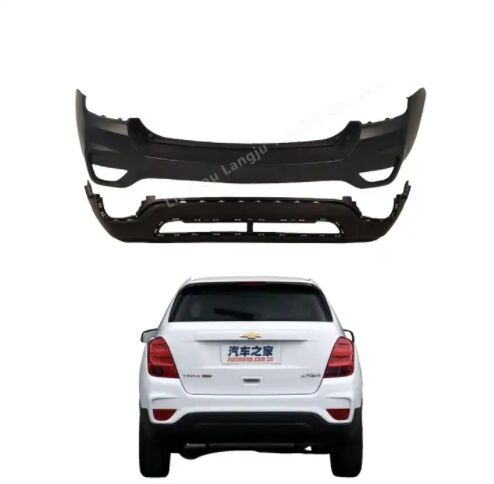Inzicht in moderne auto-bumperconstructie
De evolutie van achterbumper materialen is sinds de vroege dagen van de auto-industrie aanzienlijk veranderd. Tegenwoordig vertegenwoordigen achterbumpers een perfecte balans tussen veiligheid, esthetiek en kostenefficiëntie. Voertuigfabrikanten kiezen zorgvuldig de materialen voor achterbumpers op basis van meerdere factoren, waaronder slagvastheid, gewichtsreductie en milieubeschouwingen. Het begrijpen van deze materialen helpt zowel fabrikanten als consumenten bij het maken van weloverwogen beslissingen over voertuigveiligheid en onderhoud.
Belangrijkste materialen in moderne achterbumpers
Thermoplastische Olefinen (TPO)
Thermoplastische olefinen zijn de afgelopen twee decennia steeds populairder geworden als materiaal voor achterbumpers. Deze geavanceerde polymeren bieden uitzonderlijke duurzaamheid bij relatief lage productiekosten. TPO combineert polypropyleen met elastomeren, waardoor een materiaal ontstaat dat zowel flexibel als slagvast is. Fabrikanten waarderen TPO met name om zijn vermogen extreme temperaturen te weerstaan en chemische degradatie te weerstaan.
De veelzijdigheid van TPO gaat verder dan zijn beschermende eigenschappen. Dit materiaal kan eenvoudig worden gevormd tot complexe vormen, waardoor ontwerpers meer vrijheid hebben bij het creëren van aerodynamische en esthetisch aantrekkelijke achterbumperontwerpen. Bovendien is TPO recyclebaar, waardoor het een milieuvriendelijke keuze is voor moderne voertuigen.
Polypropyleencomposieten
Polypropyleencomposieten vormen nog een belangrijke categorie van materialen voor achterbumpers. Deze materialen combineren traditioneel polypropyleen met verschillende versterkende middelen om de sterkte en duurzaamheid te verbeteren. Het resulterende composiet biedt uitstekende slagvastheid en blijft tegelijkertijd licht van gewicht, wat bijdraagt aan de algehele voertuigefficiëntie.
Moderne polypropyleencomposieten bevatten vaak glasvezels of minerale vulstoffen, die de structurele integriteit van het materiaal aanzienlijk verbeteren. Deze toevoegingen helpen de vorm van de bumper te behouden bij lichte botsingen en voorkomen vervorming onder extreme temperatuurcondities. De kostenefficiëntie en eenvoudige verwerkbaarheid van het materiaal maken het bijzonder aantrekkelijk voor massamarktvoertuigen.

Geavanceerde ingenieursmaterialen
Versterkte kunststofverbindingen
De auto-industrie blijft innoveren met versterkte kunststofverbindingen voor toepassingen in achterbumpers. Deze materialen combineren verschillende polymeren met versterkende middelen om uitzonderlijk duurzame onderdelen te creëren. Moderne versterkte kunststoffen kunnen aanzienlijke impactkrachten weerstaan terwijl ze hun structurele integriteit behouden, waardoor ze ideaal zijn voor veiligheidskritische toepassingen.
Ingenieurs voegen vaak koolstofvezels of gespecialiseerde harsen toe aan deze verbindingen, waardoor zowel de sterkte als de lichtgewicht eigenschappen worden verbeterd. De resulterende materialen voor achterbumpers bieden superieure prestatie-eigenschappen en dragen bovendien bij aan een betere brandstofefficiëntie door gewichtsreductie.
Hoogwaardig polyurethaan
Polyurethaan met hoge impactweerstand is uitgegroeid tot een premiumkeuze voor achterbumpermaterialen, met name in luxe- en prestatieauto's. Dit materiaal biedt uitstekende energieabsorptie-eigenschappen en behoudt tegelijkertijd uitstekende esthetische kwaliteiten. Fabrikanten kunnen nauwkeurige oppervlakteafwerkingen en complexe geometrieën realiseren, terwijl ze een maximale veiligheidsprestatie waarborgen.
De flexibiliteit van polyurethaan biedt ruimte voor innovatieve ontwerpoplossingen, zoals geïntegreerde sensoren en parkeerhulpsystemen. De uitstekende weerstandsvermogen tegen weersinvloeden en kleurvervaging maakt het bijzonder geschikt voor voertuigen die blootgesteld worden aan extreme weersomstandigheden.
Metaal en hybride oplossingen
Aluminium versterkingen
Hoewel de meeste moderne bumperkleppen gebruikmaken van kunststofmaterialen voor hun buitenste schalen, spelen aluminium versterkingen een cruciale rol in de algehele bumperopbouw. Deze lichte metalen componenten bieden structurele ondersteuning en helpen het krachtopvangende vermogen over het voertuigframe te verdelen. De combinatie van aluminium versterkingen met kunststofbekleding creëert een optimale balans tussen bescherming en gewichtsefficiëntie.
Fabrikanten gebruiken vaak gespecialiseerde aluminiumlegeringen die een verbeterde sterkte-gewichtverhouding bieden. Deze materialen dragen bij aan een betere crashprestatie, terwijl ze de trend in de automobielindustrie naar lichtere en brandstofefficiëntere voertuigen ondersteunen.
Staal-Kunststof Hybridsystemen
Innovatieve hybridesystemen die stalen elementen combineren met geavanceerde kunststoffen, representeren de nieuwste ontwikkelingen op het gebied van materialen voor bumperplaten. Deze geavanceerde oplossingen maken gebruik van de beste eigenschappen van beide materialen om zeer effectieve beschermingssystemen te creëren. Stalen componenten bieden maximale sterkte in kritieke zones, terwijl kunststofelementen gewichtsvoordelen en vormgevingsmogelijkheden bieden.
De integratie van deze materialen vereist geavanceerde productietechnieken, waaronder overgieten en chemische verbindingsprocessen. Het resultaat is een achterbumper-systeem dat de traditionele prestatie-indicatoren te boven gaat en tegelijkertijd voldoet aan moderne eisen voor vormgeving en efficiëntie.
Milieubeschouwingen en toekomstige trends
Recyclebare materialen
De focus van de auto-industrie op duurzaamheid heeft geleid tot een vergroot ontwikkelingsinzet voor recyclebare achterbumpermaterialen. Fabrikanten investeren in nieuwe polymeerblends die hoge prestatieniveaus behouden, terwijl ze verbeterde recyclingmogelijkheden bieden aan het einde van de levenscyclus. Deze materialen bevatten vaak gerecycled materiaal zonder dat dit ten koste gaat van de structurale stabiliteit of het uiterlijk.
Moderne recyclagetechnologieën maken tegenwoordig efficiëntere materiaalherwinning en verwerking mogelijk, waardoor duurzame achterbumpermaterialen steeds levensvatbaarder worden voor massaproductie. Deze trend sluit aan op wereldwijde inspanningen om de autowrakvermindering en het milieu-impact te verminderen.
Bio-gebaseerde Alternatieven
Onderzoek naar biobasede materialen voor achterbumpers staat aan de basis van een spannend nieuw gebied binnen de autotechniek. Deze innovatieve materialen worden gedeeltelijk of volledig geproduceerd uit hernieuwbare grondstoffen en bieden mogelijke milieuvriendelijke voordelen, terwijl ze de vereiste prestaties behouden. Verschillende fabrikanten onderzoeken natuurlijke vezelversterkingen en bio-afgeleide polymeren als alternatieven voor traditionele op aardolie gebaseerde materialen.
Hoewel deze duurzame oplossingen zich nog in ontwikkeling bevinden, lijken ze veelbelovend voor toekomstige toepassingen. Vooruitgang in materiaalkunde zorgt ervoor dat bio-based oplossingen steeds beter haalbaar worden, wat de constructie van achterbumpers in de komende jaren mogelijk kan revolutioneren.
Veelgestelde Vragen
Wat maakt moderne bumpermaterialen anders dan traditionele materialen?
Moderne materialen voor achterbumpers bevatten geavanceerde polymeren, composieten en hybride oplossingen die een betere weerstand tegen impact, lichter gewicht en meer flexibiliteit in design bieden vergeleken met traditionele metalen bumpers. Ze beschikken ook over verbeterde recycleerbaarheid en integreren vaak slimme technologieën.
Hoe lang zijn de huidige materialen voor achterbumpers doorgaans bruikbaar?
Met een juiste onderhoudsbeurt kunnen moderne achterbumpermaterialen de levensduur van het voertuig meegaan. Factoren zoals UV-blootstelling, temperatuurextremen en beschadigingen door impact kunnen echter de levensduur beïnvloeden. De meeste materialen zijn ontworpen om hun structurele integriteit en uiterlijk minstens 10 tot 15 jaar te behouden onder normale omstandigheden.
Zijn achterbumpermaterialen op plasticbasis net zo veilig als metalen varianten?
Ja, moderne kunststofachterbumpers zijn ontwikkeld om te voldoen aan of zelfs te verbeteren op de veiligheidsnormen. Ze bieden vaak betere energieabsorptie en krachtdistributie dan traditionele metalen bumpers, terwijl hun lichtere gewicht bijdraagt aan een betere voertuigefficiëntie en besturing.

